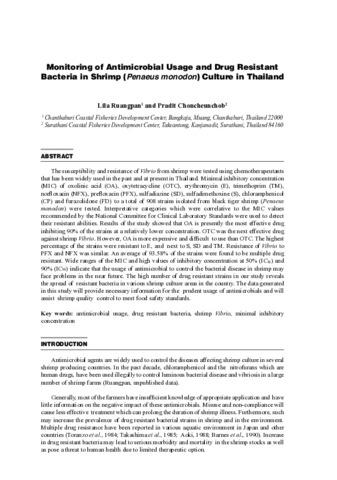Monitoring of antimicrobial usage and drug resistant bacteria in shrimp (Penaeus monodon) culture in Thailand
- Global styles
- MLA
- Vancouver
- Elsevier - Harvard
- APA
- Help

Date
2005-03Page views
2,212ASFA keyword
AGROVOC keyword
Taxonomic term
Metadata
Show full item record
Share
Abstract
The susceptibility and resistance of Vibrio from shrimp were tested using chemotherapeutants that has been widely used in the past and at present in Thailand. Minimal inhibitory concentration (MIC) of oxolinic acid (OA), oxytetracycline (OTC), erythromycin (E), trimethoprim (TM), norfloxacin (NFX), prefloxacin (PFX), sulfadiazine (SD), sulfadimethoxine (S), chloramphenicol (CP) and furazolidone (FD) to a total of 908 strains isolated from black tiger shrimp (Penaeus monodon) were tested. Interpretative categories which were correlative to the MIC values recommended by the National Committee for Clinical Laboratory Standards were used to detect their resistant abilities. Results of the study showed that OA is presently the most effective drug inhibiting 90% of the strains at a relatively lower concentration. OTC was the next effective drug against shrimp Vibrio. However, OA is more expensive and difficult to use than OTC. The highest percentage of the strains were resistant to E, and next to S, SD and TM. Resistance of Vibrio to PFX and NFX was similar. An average of 93.58% of the strains were found to be multiple drug resistant. Wide ranges of the MIC and high values of inhibitory concentration at 50% (IC50) and 90% (IC90) indicate that the usage of antimicrobial to control the bacterial disease in shrimp may face problems in the near future. The high number of drug resistant strains in our study reveals the spread of resistant bacteria in various shrimp culture areas in the country. The data generated in this study will provide necessary information for the prudent usage of antimicrobials and will assist shrimp quality control to meet food safety standards.
Suggested Citation
Ruangpan, L., & Choncheunchob, P. (2005). Monitoring of antimicrobial usage and drug resistant bacteria in shrimp (Penaeus monodon) culture in Thailand. In K. Nagasawa (Ed.), Recent Advances in Diagnosis and Prevention of Fish and Shrimp Diseases in Southeast Asia (pp. 347–359). Tigbauan, Iloilo, Philippines: Aquaculture Department, Southeast Asian Fisheries Development Center.
Type
Book chapterISBN
9718511732
Related items
Showing items related by title, author, creator and subject.
-
An overview of the nutrition, feed and feeding techniques of prawn penaeid/shrimps
Piedad-Pascual, Felicitas (Philippine Council for Aquatic and Marine Research and Development, 1989)This paper echoes what transpired during the first International Conference of Penaeid Prawns/Shrimps held in Iloilo City in December 4-7, 1984, particularly on the Nutrition nd Feed Development. Around 25 papers were ... -
Series: Aquaculture extension manual; No. 19
Prawn hatchery operations
Parado-Estepa, Fe D.; Quinitio, Emilia T. ; Borlongan, Emeterio L. (Aquaculture Department, Southeast Asian Fisheries Development Center, 1996-05)
The manual, an updated version of the 1984 SEAFDEC/AQD manual, presents the underlying principles and step-by-step instructions of prawn larval and post-larval rearing. The techniques described are not only applicable to ...
; Borlongan, Emeterio L. (Aquaculture Department, Southeast Asian Fisheries Development Center, 1996-05)
The manual, an updated version of the 1984 SEAFDEC/AQD manual, presents the underlying principles and step-by-step instructions of prawn larval and post-larval rearing. The techniques described are not only applicable to ... -
The lowdown on world shrimp culture - II
Yap, Wilfredo G. (INFOFISH, 2001)This paper introduces some new members of the international shrimp culture club and goes on to discuss some recent technological innovations in the industry, particularly the polyculture of tilapia (mainly Oreochromis ...

 AQD Access
AQD Access




